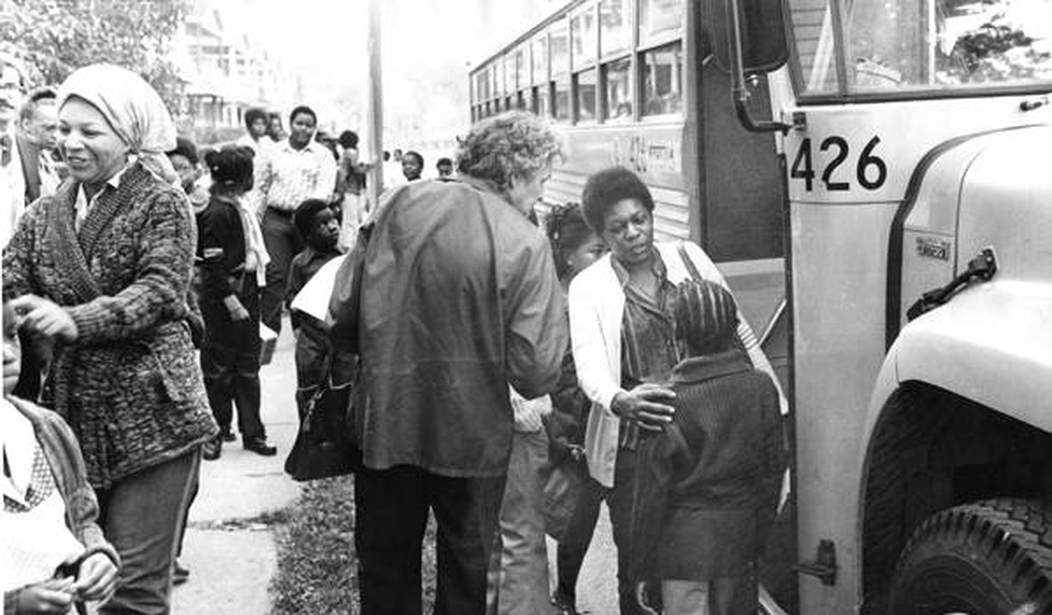During Thursday night’s Democratic debate, California Senator Kamala Harris blasted former Vice President Joe Biden for not supporting school busing when he was a member of the Senate. In the ensuing days, several Democratic presidential hopefuls have come out in support of resurrecting a failed policy that Americans have opposed for decades — that is, the forced busing of students out of their neighborhood schools in order to achieve a desired racial balance.
“I will direct this at Vice President Biden, I do not believe you are a racist, and I agree with you when you commit yourself to the importance of finding common ground, but I also believe and it’s personal and it was hurtful to hear you talk about the reputations of two United States senators who built their reputations and career on the segregation of race in this country,” said Harris, referencing Biden’s recent statements highlighting his ability to work with two segregationists—both of whom were Democrats—during his time in the Senate.
In a dramatic moment that was clearly choreographed to decimate Biden’s presidential aspirations Harris added, “It was not only that, but you also worked with them to oppose busing. There was a little girl in California who was part of the second class to integrate her public schools and she was bused to school every day. That little girl was me.” She further asserted that “I was part of the second class to integrate Berkeley, California, public schools almost two decades after Brown v. Board of Education.”
Whether or not Harris’ recollection of her time in the Berkeley public schools is accurate has been the subject of much debate. The Sacramento Bee said that “While it’s true she was among the second class of students at Thousand Oaks Elementary School to participate in a fully integrated busing program, she was far from the first black child to attend the school.”
According to the Bee, “Data from the Berkeley Unified School District shows the school had 15 black students in 1963 — a year before Harris was born. They represented 3% of the total elementary school student body, while other schools in the district had a black population as high as 97%.”
CNN, however, came to a different conclusion, declaring that Harris was telling the truth. “Harris was indeed part of the second integrated class at Berkeley’s Thousand Oaks Elementary School: she entered school in 1969, and the plan to desegregate the school was implemented in 1968,” CNN wrote, focusing on the semantics of the official integration plan that commenced in 1968 rather than the actual integration of the schools prior to the mandates.
At any rate, Harris’ charges aimed at Biden have reignited the debate over forced school busing, the failed 1970s-era policy of shipping off white children to predominantly black schools and vice versa. The idea was that black children would have better opportunities to succeed at schools in predominantly white suburban districts and that integration would help to improve the quality of inner-city schools, many of which were at the time—as they are today—crime-ridden and failing academically. In 1971 the Supreme Court ruled in Swann v. Charlotte-Mecklenburg Board of Education that busing could be an appropriate way to solve the problem of segregated schools. Not long after, federal courts began ruling that some districts—in Boston, Massachusetts; Cleveland and Columbus, Ohio; Kansas City, Missouri; Pasadena and San Francisco, California; Richmond, Virginia; Detroit, Michigan; and Wilmington, Delaware—must institute forced school busing to abrogate segregation.
Children faced long bus rides to and from school—in some cases over an hour—while parents missed out on opportunities to be involved in the education of their children. Instead of being right down the block, their schools were now far from home. Even at the height of the school busing program, Americans—both black and white—opposed it by an overwhelming majority. Gallup reported in 1973 that while the majority of Americans supported integration, only 5 percent—9 percent of blacks and 4 percent of whites—thought that busing children to other districts was the best way to achieve that goal. (A 1999 Gallup poll, the most recent I could find, discovered that only 15 percent of Americans supported transferring students out of their neighborhood schools to achieve integration goals.)
In the end, the policy failed to achieve its goals, barely moving the needle on the number of children attending integrated schools—from 1972 to 1980 the percentage of black students attending mostly-black schools dropped almost imperceptibly, from 63.6 percent to 63.3 percent.
Tanner Colby, writing at Slate in 2014, argued that black parents in the 1970s, by and large, weren’t demanding desegregation, they were demanding “agency, the right to exercise control over their lives and, hopefully, to enjoy the full protection of the government while doing so.”
“Black schools were unilaterally closed down, their students divvied up and distributed to whatever white school needed to adjust its numbers in order to avoid being sued, often over the very loud protests of black parents; at angry town hall meetings, integration was denounced as a white supremacist plot to destroy the black community,” Colby explained. “Some black students, fearing the prospect of a hostile white environment, dropped out of school rather than ride the bus.” Those who could afford it sent their children to private schools to avoid forced busing (the same was true, and in greater numbers, for white parents—including the likes of Senators Ted Kennedy and George McGovern, and Washington Post editor Ben Bradlee, all of whom supported busing, albeit for other people’s children.)
“Not all black parents believed in integration,” Colby continued. “Those who did wanted a say in how it played out for their children. Some busing programs were voluntary, but by and large black children had to bus where [the Department of Health, Education, and Welfare] told them to bus. Mandatory racial-balance requirements insisted on it. With Jim Crow, black America lived under an onerous, top-down system that told them where their children could and could not go to school. Now, with busing, black America lived under … an onerous, top-down system that told them where their children could and could not go to school.”
Democratic presidential candidates, who are increasingly out of step with their constituents, are choosing to pander to the radical fringe of the party by resurrecting the busing issue, stirring up racial divisions wherever they can—even if that means destroying one of their own. (Incongruously, this all comes at a time when many on the far-left are demanding segregated spaces, including segregated college dormitories and graduation ceremonies.)
Harris’ campaign confirmed that the California senator does indeed support bringing back busing, telling the New York Times that she “supported busing as a method for school integration,” but declining to provide details on what such a plan would entail. Ian Sams, Harris’ national campaign manager replied with a simple “yes” when asked on Twitter whether she supports “busing for school integration right now.”
Conn Carroll, communications director for Sen. Mike Lee (R-Utah), tweeted that all Democratic senators should be asked to weigh in on forced busing.
In addition to Harris, several other Democratic presidential contenders have expressed support for the failed policy.
On Friday, Sen. Warren reiterated her support for forced federal school busing programs to ensure racial quotas. “I’m already on record on busing and using busing as a way to help communities that are diversifying,” Warren told reporters after a rally in Chicago.
Indeed, Warren, along with Sen. Bernie Sanders, a fellow presidential hopeful and avowed socialist, cosponsored the Strength in Diversity Act, which would provide $120 million in grants in the hopes of increasing diversity in the nation’s public schools, in part, by reintroducing busing.
Sanders explained his support for the idea of forced busing: “I am really concerned about the growing segregation — once again — the resegregation of communities all over this country. We’re seeing more and more schools which are being segregated. And that is something we have to deal with. Busing is one tool.”
Sen. Kirsten Gillibrand also said she supports it: “I think every child should be able to go to a good public school. And as president, I will assure that. If it needs busing, it needs busing,” she told reporters.
While Democrats squabble over unpopular and failed policies like school busing, Americans—of all races—have consistently expressed support for school choice programs that let parents decide which schools and educational methods are best for their children. A Democratic polling firm found in 2018 that fully 63 percent of likely voters support school choice, including 41 percent who strongly support it. The poll found that “72% of Latinos, 61% of whites, 66% of African Americans, 75% of Republicans, 62% of Independents, and 54% of Democrats support school choice.”
Unlike forced busing, school choice programs have been largely successful, improving academic outcomes, graduation rates, college enrollment, civic engagement, crime rates, and parental and student satisfaction. School choice programs even help to improve traditional public schools.
Despite the evidence and the polling data, Democrats continue to fight tooth and nail to deny parents educational choices like charter schools, vouchers for private schools, and homeschooling—because they think they know better than parents what’s best for other people’s children. Moreover, they want the forced indoctrination that traditional public schools provide because they know it works—the pervasive snowflake culture in our universities is a testament to their success. Non-traditional educational options provide opportunities that were once out of reach to disadvantaged students, but you’ll rarely if ever (Cory Booker is one of the few exceptions) hear a Democrat say that. If they really cared about disadvantaged children they would all be wearing “Support School Choice” t-shirts and shouting its praises from the rooftops. Instead, we see them pushing a failed, coercive policy that is almost universally despised.
Good luck with that in 2020.
Follow me on Twitter @pbolyard










Join the conversation as a VIP Member